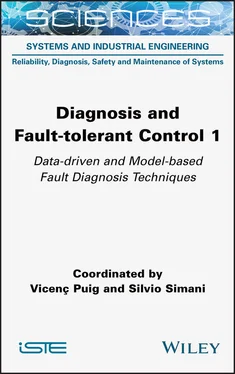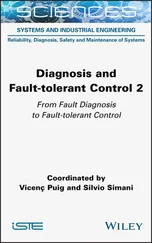1 Cover
2 Title page SCIENCES Systems and Industrial Engineering , Field Director – Jean-Paul Bourrières Reliability, Diagnosis, Safety and Maintenance of Systems , Subject Head – Jean-Marie Flaus
3 Copyright First published 2021 in Great Britain and the United States by ISTE Ltd and John Wiley & Sons, Inc. Apart from any fair dealing for the purposes of research or private study, or criticism or review, as permitted under the Copyright, Designs and Patents Act 1988, this publication may only be reproduced, stored or transmitted, in any form or by any means, with the prior permission in writing of the publishers, or in the case of reprographic reproduction in accordance with the terms and licenses issued by the CLA. Enquiries concerning reproduction outside these terms should be sent to the publishers at the undermentioned address: ISTE Ltd 27-37 St George’s Road London SW19 4EU UK www.iste.co.uk John Wiley & Sons, Inc. 111 River Street Hoboken, NJ 07030 USA www.wiley.com © ISTE Ltd 2021 The rights of Vicenç Puig and Silvio Simani to be identified as the authors of this work have been asserted by them in accordance with the Copyright, Designs and Patents Act 1988. Library of Congress Control Number: 2021943898 British Library Cataloguing-in-Publication Data A CIP record for this book is available from the British Library ISBN 978-1-78945-058-3 ERC Code: PE7 Systems and Communication Engineering PE7_1 Control engineering
4 Introduction Introduction Vicenç PUIG1 and Silvio SIMANI2 1Institute for Robotics and Industrial Informatics, Polytechnic University of Catalonia, Barcelona, Spain 2Department of Engineering, University of Ferrara, Emilia-Romagna, Italy
5 1 Mathematical Modeling and Fault Description
1.1. Introduction
1.2. Model-based FDI techniques
1.3. Modeling of faulty systems
1.4. Residual generation
1.5. Residual generation techniques
1.6. Change detection and symptom evaluation
1.7. Residual generation robustness problem
1.8. Fault diagnosis technique integration
1.9. Conclusion
1.10. References
6 2 Structural Analysis
2.1. Introduction
2.2. Background
2.3. Fault isolability analysis
2.4. Testable submodels
2.5. Sensor placement
2.6. Summary and discussion
2.7. References
7 3 Set-based Fault Detection and Isolation
3.1. Introduction
3.2. Notations, definitions and properties
3.3. Problem statement
3.4. Proposed techniques
3.5. Design methods
3.6. Fault detection and isolation procedures
3.7. Application example: quadruple-tank system
3.8. Conclusion
3.9. References
8 4 Diagnosis of Stochastic Systems
4.1. Introduction
4.2. Stochastic diagnosis task
4.3. Inference methods for diagnosis task
4.4. Model-based approach
4.5. Data-driven approaches
4.6. Hybrid approaches: surrogate methods
4.7. Comparative analysis of approaches
4.8. Summary and conclusions
4.9. References
9 5 Data-Driven Methods for Fault Diagnosis
5.1. Introduction
5.2. Models for linear system fault diagnosis
5.3. Parameter estimation methods for fault diagnosis
5.4. Nonlinear dynamic system identification
5.5. Fuzzy data-driven approach to fault diagnosis
5.6. Fuzzy model identification
5.7. Conclusion
5.8. References
10 6 The Artificial Intelligence Approach to Model-based Diagnosis
6.1. Introduction
6.2. Case studies
6.3. Knowledge-based diagnosis systems
6.4. Model-based diagnosis
6.5. CBD for dynamic systems
6.6. Conclusion
6.7. References
11 List of Authors
12 Index
13 Summary of Volume 2
14 End User License Agreement
1 Introduction Figure I.1. Comparison between hardware and analytical redundancy schemes Figure I.1. Comparison between hardware and analytical redundancy schemes In practice, the most frequently used diagnosis method is to monitor the level (or trend) of the residual and take action when the signal reaches a given threshold. This method of geometrical analysis , while simple to implement, has a few drawbacks. The most important is that, in the presence of noise, input variations and change of operating point of the monitored process, false alarms are possible. The major advantage of the model-based approach is that no additional hardware components are required to implement an FDI algorithm as well as FTC. A model-based FDI algorithm can be implemented via software on a process control computer. In many cases, the measurements necessary to control the process are also sufficient for the FDI algorithm, so no additional sensors have to be installed (Patton et al . 1989; Basseville and Nikiforov 1993; Chen and Patton 1999). Analytical redundancy uses a mathematical model of the system under investigation and therefore it is often referred to as the model-based approach to fault diagnosis.
Figure I.2. Scheme for the model-based fault diagnosis Figure I.2. Scheme for the model-based fault diagnosis Basic process model-based FDI methods have been described by Patton et al . (1989, 2000), Basseville and Nikiforov (1993), Gertler (1998) and Chen and Patton (1999), which include the following steps: 1 1) output observers (OO, estimators, filters); 2 2) parity equations; 3 3) identification and parameter estimation. These methods generate residuals for output variables with fixed parametric models using step 1, fixed parametric or non-parametric models using step 2 and adaptive non-parametric or parametric models using step 3. An important aspect of these methods is the kind of fault to be detected. As noted above, one can distinguish between additive faults , which influence the variables of the process by summation, and multiplicative faults , which are products of the process variables. The basic methods show different results, depending on the type of fault. If only output signals y ( t ) can be measured, signal model-based methods can be applied, for example, vibrations can be detected, which are related to rotating machinery or electrical circuits. Typical signal model-based methods of fault detection are as follows: 1 1) bandpass filters; 2 2) spectral analysis (FFT); 3 3) maximum-entropy estimation. The characteristic quantities or features from fault detection methods show stochastic behavior with mean values and variances. Deviations from the normal behavior must then be detected by methods of change detection (residual analysis, Figure I.2 ), such as: 1 1) mean and variance estimation; 2 2) likelihood-ratio test, Bayes decision; 3 3) run-sum test.
Figure I.3. Fault estimation scheme FTC
2 Chapter 1 Figure 1.1. Structure of the model-based FDI system Figure 1.2. Closed-loop FDI system Figure 1.3. The rearranged FDI scheme Figure 1.4. Monitored system and fault topology Figure 1.5. The monitored system and fault typology Figure 1.6. The structure of the plant sensors Figure 1.7. Fault topology with actuator input signal measurement Figure 1.8. Residual generator general structure Figure 1.9. System simulator or output estimator for residual generation Figure 1.10. Transfer function residual generator Figure 1.11. Parameter estimation Equation Error (EE) Figure 1.12. Parameter estimation Output Error (OE) Figure 1.13. State and output dynamic observer Figure 1.14. MIMO process with faults and noisesFigure 1.15. Process and output observerFigure 1.16. Parity equation methods: (a) EE and (b) OEFigure 1.17. Parity EE methods for a MIMO modelFigure 1.18. Neuro-fuzzy-based FDI schemeFigure 1.19. TSK NF-based FDI scheme
Читать дальше












